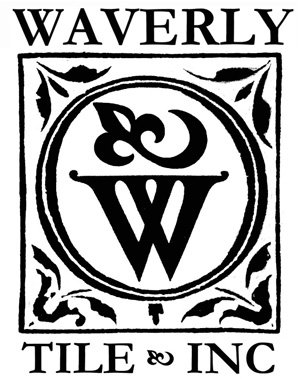
Waverly Tile Installation and Care Guide
Understanding Natural Stone Characteristics: Natural stone is a beautiful and unique material, and understanding its inherent characteristics is key to achieving the best results in your installation. Please note the following information to ensure a smooth installation process and long-lasting beauty: color, veining, fissures, shading, and size are true characteristics of natural stone. The natural variations in shade and texture of the stone can affect the color and shading of the etched design. Some stones may also have naturally occurring holes or veins, and surface variations may be present throughout the design.
Tile Blending & Inspection Before Installation: To ensure the best results, we highly recommend careful blending of the tiles to achieve a union of the stone's natural beauty and its etched design, accounting for any variations in color and texture. Inspect all tiles thoroughly before installation - installation of the product signifies acceptance, and no adjustments can be made. If the material needs to be stored prior to installation, it should be protected from extreme conditions.
Recommended Areas of Application: Our tiles come pre-sealed and ready for installation. Recommended areas of installation include:
Residential: interior walls, backsplashes and floors
Light Commercial: interior walls, backsplashes and floors
Intermittent water exposure such as shower walls installed a minimum of 8” above the shower floor
NOT recommended for installation:
Shower floors
Submerged underwater such as pools and fountains
All exterior applications except covered wall/backsplash areas
Placement and Layout: For the best results, we recommend that you butt the etched decorative tiles as closely together as possible in a dry horizontal layout first, leaving little to no grout lines. This will help ensure the decorative etched lines align perfectly, especially for wainscots and murals. You may need to blend or rotate some of the stone tiles to get everything aligned just right. Once you are satisfied with the layout, you're ready to transfer the tiles to the wall or floor for installation.
Installation: When installing your handmade decorative etched stone tiles, we recommend using a white thin-set mortar or adhesive. Be sure to select an adhesive that is specifically designed for use with natural stones. It is important to handle adhesives carefully and follow the manufacturer's instructions for best results.
Grouting Instructions: Grouting your etched tiles requires special care to avoid damaging the intricate designs. Grout can easily get trapped in the recessed etched areas, and once it dries, it becomes nearly impossible to remove. Avoid using grout remover chemicals as they can damage the protective sealers on the tile. Also, never use tape to mask the face of the tiles, as it may cause damage when removed. We recommend using grouting floats made of rubber, plastic, or polyurethane, as these materials are gentle on the surface while allowing for effective grout application. The most crucial step in grouting your etched tiles is using fresh clean water to wipe the grout lines. Be sure to avoid using dirty water, as it can leave behind a grout film that will be difficult to clean once dry.
Any grout in the recessed etched areas should be removed immediately (blotting the recesses with a very clean sponge and clean water, helps pull out the grout).
Best Grouting Practices for Optimal Results:
Arrange tiles closely together, leaving little to no grout lines, to minimize grout usage.
For better control, grout smaller areas (5-10 square feet) at a time. This gives you ample time to clean tiles and ensure the grout does not set in the etched areas.
Do not allow grout to sit on the tiles for more than 5 minutes before cleaning.
Always use fresh clean water for cleaning grout lines. Repeat as needed to ensure no grout remains in the etching.
When applying grout, be sure to push it only into the grout lines, keeping the face of the tiles as free from grout as possible.
Once grouting is complete, cleaned, and dried, apply a water-based sealer. Water-based sealers will not affect the decorative material. We recommend resealing your tiles annually, but it's important to follow the maintenance schedule provided by the sealer manufacturer for the best results.
Maintenance and Care: Regular maintenance is essential to preserving the beauty of your tiles. To care for your decorative stone tiles, clean them using a soft cloth with warm water and mild dishwashing soap. Always rinse well to remove soap residue. Sweep floors regularly with a clean, non-treated mop or soft broom. In wet areas like showers, regular cleaning helps prevent buildup, reducing the need for more intensive cleaning. Avoid using abrasive cleaning tools like scouring pads, brushes, or electric scrubbers, as well as harsh cleaners containing phosphoric acids, acetone, glycolic acids, or scouring powders. Never use homemade remedies including lemon, vinegar, and/or products with chlorine, as they can damage the stone and its protective sealer.
